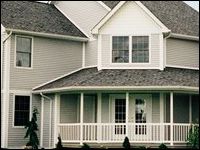Vinyl Siding - Basics, Review, Ratings
An excellence choice for siding based on its strength, versatility for multiple climates, and long-lasting quality.
- Vinyl Siding is made from PVC (polyvinyl chloride) and has begun to be used in construction more and more all the time. They can be fashioned to resemble wood.
- The average width of Vinyl Siding ranges from 6 inches to 10 inches. However, other various lengths and widths are available.
- Scratches are rarely visible, since the PVC that the siding is composed of is solid all the way through.
- Vinyl Siding is similar in many properties to aluminum, such as weight and density. However, unlike aluminum, vinyl does not dent. And besides aesthetic repair, scratched vinyl siding does not rust and will not ruin the integrity of your siding.
- Temperature will not affect Vinyl Siding, which can be installed in nearly any climate. Aluminum siding might take a long time to re-install if damaged, which is untrue of Vinyl Siding. Vinyl’s temperature at which it ignites is very high (736 F). It has half the burn time of cedar and burns one third as hard. If I fire occurs in a house with Vinyl Siding, people can expect more time to get out.
Three Parts to Vinyl Siding
- At the top of the panel itself is a nail hem, where the slots are located.
- The flat area which faces the exterior when installed
- The Butt lock is at the bottom and locks into the next panel when installed.
There are numerous accessories and add-ons that cover your seams, add accent to your siding, or do any other number of functional or aesthetic things. Siding also commonly comes with a warranty.
Maintaining Vinyl Siding

Vinyl Siding is by far the easiest exterior home covering to clean, repair and maintain in general. You’ll want to occasionally wash mildew, mold, dirt and dust from your vinyl, but other than that little care is necessary. When you do clean your siding, clean it with a soft cloth or toothbrush (if you have a faux-grain or any other texture). Normal, everyday soaps you might already have in your hope are fine to use. Remember that though it is durable, vinyl can melt. Keep grills, candles and other sources of heat far enough away from your home.
Vinyl Siding Rating Systems/Specs
| Length of panels | Can be as long as 40 feet | 12 - 12 1/2 feet is average |
| Width | 6 1/2 to 10 inches | |
| Applicable Standards | ASTM E119 | This means that the fire endurance ratings are similar to walls without vinyl. For example, having vinyl siding doesn't speed up a fire. |
| ASTM D3679 | Means that the vinyl at least met the established requirements for the methods used to test the material, dimensions, expansion, appearance and windload resistance. | |
| Thickness | Optimum panel thickness is between .038 and .48 inches. Thicker, rigid panels provide better wind resistance, protection against damage, and lay flatter and straighter. | |
| Panel Projection | The amount the panel sticks out from the side of the home. | Look for the maximum projection for the style of vinyl selected. |
| Chemistry | Look for a high concentration of titanium oxide. | |
| Formulation | High temperature fusion and after formulated manufacturing methods result in stronger panels. | |
| Windload Pressure | The amount of wind pressure the panels can take before coming off or breaking | Look for a negative windload pressure, it gives a truer picture of windload pressure than a positive test. |